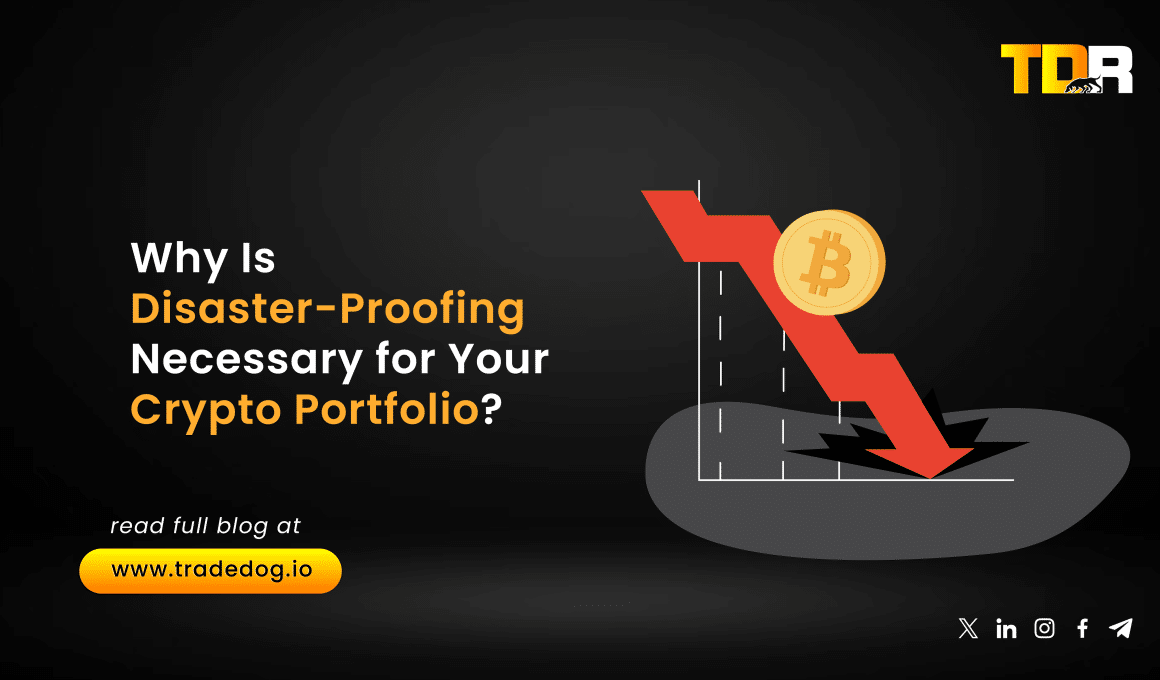Quick Links
In the volatile world of cryptocurrency, disaster-proofing your portfolio is not just a precaution- it’s a necessity. The crypto market, known for its rapid price fluctuations and unpredictable downturns, poses unique challenges that demand proactive management. As seen in recent market events, where the overall Market Capitalization shredded by over $510 Bn within 3 days, safeguarding your investments against catastrophic losses is critical. Disaster-proofing involves a series of strategies designed to minimize risk, preserve capital, and maintain liquidity during periods of extreme market stress. For investors committed to long-term success, understanding and implementing these strategies is essential to navigating the unpredictable tides of the crypto market.
What to Avoid
The first step in disaster-proofing your crypto portfolio is recognizing the assets and strategies that could amplify your risk during a downturn. A primary focus for 2024 has been on airdrops, where tokens are distributed freely to promote on-chain activity, and the associated pegged assets, such as liquid restaking tokens and synthetic dollars like Ethena’s USDe. While these assets have gained popularity due to their perceived stability and potential for returns, they are among the riskiest holdings in a bear market.
Pegged assets are particularly dangerous because their liquidity can evaporate instantly during a sell-off, leaving investors trapped in positions that they cannot exit at expected prices. The thin liquidity and potential for depegging, where the asset’s value deviates from its intended peg, pose significant risks. For example, during a market crash, liquidity providers and lenders who rely on these assets may find themselves holding depegged tokens with questionable recovery prospects, leading to substantial losses. This risk is compounded by the widespread integration of these assets in DeFi protocols, which finance billions of dollars in lending activity.
What to Seek Out
To protect your crypto portfolio during turbulent times, focusing on safer, more liquid assets is crucial. One of the most effective strategies is increasing your cash allocation, particularly in fully regulated and reserved cash-like assets. These assets, while not immune to market fluctuations, are less likely to suffer catastrophic depegging due to their strong collateralization and regulatory oversight.
USDC, for example, provides an opportunity for yield generation through platforms like Coinbase, although this introduces marginal off-chain counterparty risk. Meanwhile, USDM offers daily on-chain interest payments, making it an attractive option for those seeking stability with a yield component. These stablecoins are preferable for maintaining liquidity and preserving capital during market downturns.
For those who are more risk-tolerant but still wish to avoid crypto-specific risks, investing in long-duration U.S. Treasuries could be a viable strategy. With the global economy teetering on the brink of recession, the elevated yields on long-term Treasuries represent a significant opportunity. Unfortunately, these assets are not available on-chain, necessitating traditional finance (TradFi) rails to gain exposure.
In addition to Treasuries, tokenized money market funds such as BlackRock’s BUIDL and Franklin Templeton’s FOXBB offer another avenue for earning yield while mitigating risk. However, these instruments are better suited for accredited investors due to their limited DeFi integrations and regulatory requirements.
The Importance of Diversification
Diversification remains a cornerstone of disaster-proofing any investment portfolio, including crypto. The 10×10 Approach, which emphasizes spreading investments across various sectors to avoid overexposure to any single one, is particularly relevant in today’s volatile market. This method ensures that no single sector’s collapse can decimate your portfolio, allowing you to benefit from the successes of other sectors.
The principle of diversification extends beyond just holding different types of cryptocurrencies. It involves a mix of asset classes, including traditional assets like stocks, bonds, and gold, alongside your crypto holdings. For instance, while stocks and crypto can drive significant returns during bull markets, bonds and gold serve as defensive assets that perform well during economic downturns. This balanced mix helps protect your portfolio from severe losses, as demonstrated by historical data where diversified portfolios have consistently outperformed concentrated ones in terms of risk-adjusted returns.
For example, a portfolio heavily weighted in crypto could suffer catastrophic losses during a crash. However, by allocating a portion to stable assets like cash, gold, or bonds, you can significantly reduce your exposure to downside risk. Even if crypto prices plummet, gains in these other assets can help offset losses, preserving your overall portfolio value.
Hedging Strategies
To truly disaster-proof your portfolio, it’s essential to have a solid hedging strategy in place. This means not only diversifying your holdings but also actively managing your risk. Understanding your risk tolerance is the first step. If you’re highly risk-averse, consider a more conservative asset allocation that includes a higher proportion of stablecoins, bonds, and other low-volatility investments. On the other hand, if you have a higher risk tolerance, you might maintain a larger allocation to crypto while still holding a safety net of stable assets.
Hedging also involves preparing for potential losses. By reducing your exposure to high-risk assets and spreading your investments across less correlated asset classes, you can mitigate the impact of market downturns. Additionally, having a long-term perspective is crucial, while the crypto market can be extremely volatile in the short term, it has the potential to deliver outsized returns over the long term. Therefore, rather than reacting impulsively to market fluctuations, investors should try to maintain a disciplined approach focused on their long-term goals.
Conclusion
Disaster-proofing your crypto portfolio is not just about surviving the next downturn, it’s about thriving in the face of uncertainty. By avoiding high-risk assets, such as thinly liquid pegged tokens and poorly collateralized stablecoins, and instead focusing on safer alternatives, you can shield your investments from catastrophic losses. Ultimately, the best time to safeguard your portfolio is before disaster strikes. As the global economy faces potential challenges ahead, now is the time to reassess your crypto holdings and make strategic adjustments. By taking a proactive approach, you can protect your wealth, seize opportunities during market downturns, and position yourself for long-term success in the ever-evolving world of cryptocurrency.









